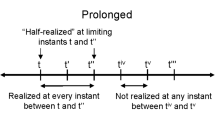Abstract
In this work we present an epistemic analysis of time phenomenon using the mathematical machinery of information theory and modular theory. By adopting limited commitment to the ontology of time evolution, and instead by mainly relying on the information that is in principle accessible to the observer, we find that the most primary aspect of the temporal experience, the perceived distinctiveness across the states of the world, emerges as a purely epistemic function. By analyzing the mathematical properties of this epistemic function, we interpret it to be in principle insensitive to any ontic state of the world, which leads to the conclusion that the observer is subject to temporal experience irrespective of whether the underlying state of the world is dynamical or invariant. On the ground of the presented analysis, we also provide a solution to the conceptual challenge of non-equilibrium phenomena that faces the thermal time hypothesis.



Similar content being viewed by others
Data Availability
Not applicable.
Code Availability
Not Applicable.
Notes
The reason behind a logarithmic definition of information content of an even is the additivity of the amount of surprise associated with the occurrence of two independent events x and y: \(-\log p_{xy} = -\log p_x -\log p_y\).
The interaction Hamiltonian is bounded.
A state \(\Psi \) is called separating for \({\mathcal {R}}_{{\mathcal {O}}}\) if \(A\vert \Psi \rangle \ne 0\) unless A=0 for all \(A\in {\mathcal {R}}_{{\mathcal {O}}}\).
\(\log \Delta \) is called the modular Hamiltonian.
Note that the relative entropy \(H_{\Psi ;\Phi }\) is a function of the local algebra \({\mathcal {R}}_{{\mathcal {O}}}\), as the modular operator is generated by both the global state and the local algebra.
References
Brough, J.B.: Husserl and the deconstruction of time. Rev. Metaphys. 46, 503–536 (1993)
Sokolowski, R.: Introduction to Phenomenology. Cambridge University Press, Cambridge (2000)
Kelly, M.R.: Phenomenology and the Problem of Time. Palgrave Macmillan, London (2016)
Wittgenstein, L.: On Certainty. Harper and Row, New York (1969)
Williams, M.: Unnatural Doubts: Epistemological Realism and the Basis of Skepticism. Princeton University Press, Princeton (1996)
Haag, R.: Local Quantum Physics: Fields, Particles, Algebras. Springer, Berlin (1992)
Diximier, J.: Von Neumann Algebras. North Holland, Amsterdam (1981)
Connes, A.: Noncommutative Geometry. Academic Press, Boston (1994)
Witten, E.: Entanglement properties of quantum field theory. Rev. Mod. Phys. 90, 045003 (2018)
Takesaki, M.: Tomita’s Theory of Modular Hilbert Algebras and Its Applications. Springer, Berlin (1970)
Connes, A., Rovelli, C.: Von Neumann algebra automorphisms and time-thermodynamics relation in generally covariant quantum theories. Class. Quantum Grav. 11(12), 2899–2917 (1994)
Swanson, N.: Can quantum thermodynamics save time? Philos. Sci. 88, 281–302 (2021)
Shannon, C.E., Weaver, W.: The Mathematical Theory of Communication. The University of Illinois Press, Urbana (1964)
Kullback, S., Leibler, R.A.: On information and sufficiency. Ann. Math. Stat. 22(1), 79–86 (1951)
Vedral, V.: The role of relative entropy in quantum information theory. Rev. Mod. Phys. 74, 197–234 (2002)
Flack, J.C.: Coarse-graining as a downward causation mechanism. Philos. Trans. R. Soc. A. 375, 20160338 (2017)
Rédei, M., Summers, S.J.: Quantum probability theory. Stud. Hist. Philos. Mod. Phys. 38, 390–417 (2007)
Murray, F.J., von Neumann, J.: On rings of operators. Ann. Math. 37, 116–229 (1936)
Murray, F.J., von Neumann, J.: On rings of operators \(\rm {II}\). Ann. Math. 41, 208–248 (1937)
Von Neumann, J.: On rings of operators \(\rm {III}\). Ann. Math. 41, 94–161 (1940)
Murray, F.J., von Neumann, J.: On rings of operators \(\rm {IV}\). Ann. Math. 44, 716–808 (1943)
Buchholz, D., Yngvason, J.: There are no causality problems for fermi’s two-atom system. Phys. Rev. Lett. 73, 613–616 (1994)
Fermi, E.: Quantum theory of radiation. Rev. Mod. Phys. 4, 87–132 (1932)
Schlieder, S.: Some remarks about the localization of states in quantum field theory. Commun. Math. Phys. 1, 265–280 (1965)
Clifton, R., Halvorson, H.: Entanglement and open systems in algebraic quantum field theory. Stud. Hist. Philos. Mod. Phys. 32, 1–31 (2001)
Nishioka, T.: Entanglement entropy: holography and renormalizatio group. Rev. Mod. Phys. 90, 035007 (2018)
Araki, H.: Relative entropy of states of von Neumann algebras. Publ. Res. Inst. Math. Sci. Kyoto 11, 809–833 (1976)
Nielsen, M.A., Chuang, I.L.: Quantum Computation and Quantum Information. Cambridge University Press, Cambridge (2012)
Connes, A., Størmer, E.: Entropy for automorphisms of \(\rm {II}_1\) von Neumann algebras. Acta Math. 134(1), 289–306 (1975)
Schumacher, B., Westmoreland, M.D.: Quantum privacy and quantum coherence. Phys. Rev. Lett. 80, 5695–5697 (1997)
Jones, V.F.R.: Index for subfactors. Invent. Math. 72, 1–25 (1983)
Bisognano, J.J., Wichmann, E.H.: On the duality condition for quantum fields. J. Math. Phys. 17, 303–321 (1976)
Hollands, S., Longo, R.: Non-equilibrium thermodynamics and conformal field theory. Commun. Math. Phys. 357, 43–60 (2018)
Rovelli, C.: The statistical state of the universe. Class. Quantum Grav. 10, 1567 (1993)
Longo, R.: The joint modular structure of an inclusion of von Neumann algebras. Contemp. Math. 62, 529–538 (1987)
Acknowledgements
The authors are grateful to Miklós Rédei, Roberto Longo, Klaus Fredenhagen and Carlo Rovelli for insightful discussions.
Funding
This research has received funding and support from the European Union’s Horizon 2020 research and innovation programme under grant agreement n. 758145 and the project CHRONOS (PID2019-108762GB-I00) of the Spanish Ministry of Science and Innovation.
Author information
Authors and Affiliations
Corresponding authors
Ethics declarations
Conflict of interest
The authors do not have any relevant financial or non-financial interests to disclose.
Additional information
Publisher's Note
Springer Nature remains neutral with regard to jurisdictional claims in published maps and institutional affiliations.
Rights and permissions
About this article
Cite this article
Farshi, F.H., DeBianchi, S. An Epistemic Analysis of Time Phenomenon. Found Phys 52, 63 (2022). https://doi.org/10.1007/s10701-022-00583-9
Received:
Accepted:
Published:
DOI: https://doi.org/10.1007/s10701-022-00583-9




